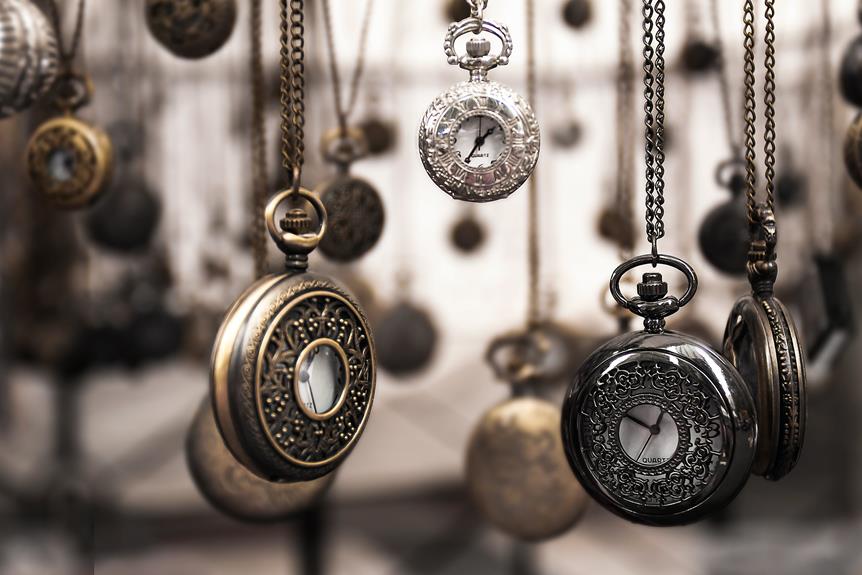Article Contents
Step into the captivating world of antique jewelry as we unravel its mysteries and complexities.
From the age-defining characteristics of true antiquity to the market-driven allure of collectible pieces, our comprehensive exploration delves into the nuances and classifications within this storied realm.
Gain insight into estate, period, and reproduction jewelry, and discover the unique characteristics, market values, and desirability that make antique jewelry a fascinating and sought-after treasure for collectors and enthusiasts alike.
Table of Contents
Key Takeaways About Antique Jewelry
- Antique jewelry is defined as jewelry that is at least 100 years old and is recognized for import of duty-free goods.
- Estate jewelry refers to second-hand or previously-owned jewelry, including antique and modern ones.
- Dealers prefer to refer to newer jewelry as period jewelry because of its style and craftsmanship.
- Market demand determines what jewelry is considered collectible, which can include both antique and contemporary pieces.
Age and Classification of Antique Jewelry
When categorizing antique jewelry, the defining factor is its age of at least 100 years. Determining authenticity and evaluating value are crucial aspects of assessing antique jewelry.
Authenticity can be established through hallmarks, maker’s marks, and the use of genuine materials consistent with the era of production. Additionally, seeking professional appraisal and certification can provide assurance of authenticity.
Evaluating the value of antique jewelry involves considering factors such as rarity, condition, provenance, and current market demand. Understanding the historical significance and craftsmanship of the piece is essential in determining its value.
Professional jewelers and appraisers play a significant role in providing accurate assessments of antique jewelry. Attention to detail and thorough research are imperative when dealing with these valuable and historically rich pieces.
Understanding Estate Jewelry
Estate jewelry is frequently misunderstood, yet it plays a significant role in the world of antique and vintage jewelry.
- Historical significance of estate jewelry
- Often carries a rich history, having been passed down through generations
- Offers a glimpse into the fashion, social, and economic trends of its time
- Evaluating the value of estate jewelry
- Consider factors such as craftsmanship, materials, and historical provenance
- Professional appraisal by a certified gemologist or antique jewelry expert is crucial for accurate valuation
- Distinction from other types of jewelry
- Differs from antique jewelry in that it includes both vintage and modern pieces
- Can encompass a wide range of styles and periods, reflecting diverse tastes and trends over time
- Market demand and collectibility
- Popular estate jewelry pieces with unique designs or historical significance may command higher prices
- Collectors may seek out specific estate jewelry items for their rarity or unique features
Exploring Period Jewelry Styles
Exploring period jewelry styles provides valuable insights into the evolution of design and craftsmanship over distinct historical eras. This exploration involves delving into the diverse styles and techniques that have emerged over time, from the elegant and intricate Art Deco pieces to the bold and geometric Retro designs. One can gain a deeper appreciation for the artistry and creativity of each period by studying the different materials and cultural influences that shaped jewelry styles. For example, the eloise fiorentino jewellery collection showcases the delicate and romantic aesthetic of Edwardian jewelry, while also highlighting the bold and avant-garde elements of the Modernist movement. By studying period jewelry styles, we can gain a better understanding of the societal trends and fashion preferences that have influenced design throughout history.
It also entails examining the influence of cultural movements on jewelry, uncovering how societal shifts and artistic trends have shaped the aesthetics and materials used in different periods.
Furthermore, exploring contemporary interpretations of period jewelry allows for a deeper understanding of how traditional styles continue to inspire modern artisans, creating a bridge between the past and the present in the world of jewelry design.
Collectible Jewelry Market Insights
The collectable jewelry market offers a captivating glimpse into the enduring allure and value of antique and modern pieces, reflecting discerning collectors’ diverse tastes and preferences.
Factors influencing the value of collectable jewelry:
- Rarity and uniqueness of the piece
- Historical or cultural significance
- Condition and provenance
- Designer or brand association
The impact of market trends on the collectable jewelry industry:
- Shifting preferences for certain styles or eras
- Influence of celebrity endorsements or publicized auctions
- Economic factors affecting discretionary spending
- Technological advancements impacting materials and production techniques
As the market for collectible jewelry continues to evolve, these factors and trends play a crucial role in shaping the value and desirability of these timeless pieces.
Identifying Reproduction and Revival Styles
In collectable jewelry market insights, the identification of reproduction and revival styles is an essential aspect for discerning collectors and enthusiasts.
When evaluating authenticity, it is crucial to be aware of common mistakes that can lead to misconceptions. Reproduction jewelry, often mistaken for originals, are exact copies of older styles.
Revival jewelry, on the other hand, creatively refashions design elements from previous eras. Some revival styles, such as Renaissance, Egyptian, and archeological revivals, can be almost as valuable as the originals.
It is important to note that revival jewelry is easily identifiable as having elements from a previous era, and a thorough understanding of these styles is imperative to accurately discern between original antique pieces and their reproductions or revivals.

